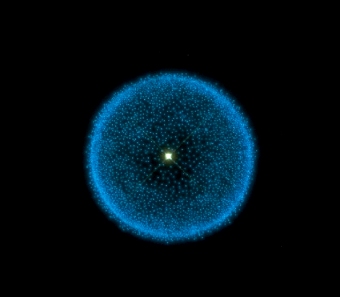|

The Oort cloud (sometimes called the Öpik-Oort
cloud) is a spherical cloud around a star or other celestial body,
composed of tiny ice particles, dust and other debris, situated where
the star's influences are counter-balanced by the aggregate of forces
external to the star. In 2369, to detect Maquis ships coming into the
Bryma system to launch a possible attack on the Cardassian colony on
Bryma, Chief O'Brien hid a dozen sensor probes in the Oort cloud of the
star system, where the Maquis wouldn't be able to detect them. (DS9:
"The Maquis, Part II").
Our own Solar System's Oort cloud is a spherical cloud
of comets believed to lie roughly 50 000 AU, or nearly a light-year,
from the Sun. The distance places the cloud at nearly a quarter of the
distance to Proxima Centauri, the nearest star to the Sun. The Kuiper
belt and scattered disc, the other two known reservoirs of
trans-Neptunian objects, are less than one thousandth the Oort cloud's
distance. The outer extent of the Oort cloud defines the gravitational
boundary of our Solar System.
The Oort cloud is thought to comprise two separate
regions: a spherical outer Oort cloud and a disc-shaped inner Oort
cloud, or Hills cloud. Objects in the Oort cloud are largely composed
of ices, such as water, ammonia, and methane. Astronomers believe that
the matter comprising the Oort cloud formed closer to the Sun and was
scattered far out into space by the gravitational effects of the giant
planets early in the Solar System's evolution.
Although no confirmed direct observations of the Oort
cloud have been made, astronomers believe that it is the source of all
long-period and Halley-type comets entering the inner Solar System and
many of the Centaurs and Jupiter-family comets as well. The outer Oort
cloud is only loosely bound to the Solar System, and thus is easily
affected by the gravitational pull both of passing stars and of the
Milky Way galaxy itself. These forces occasionally dislodge comets from
their orbits within the cloud and send them towards the inner Solar
System.
|
|
